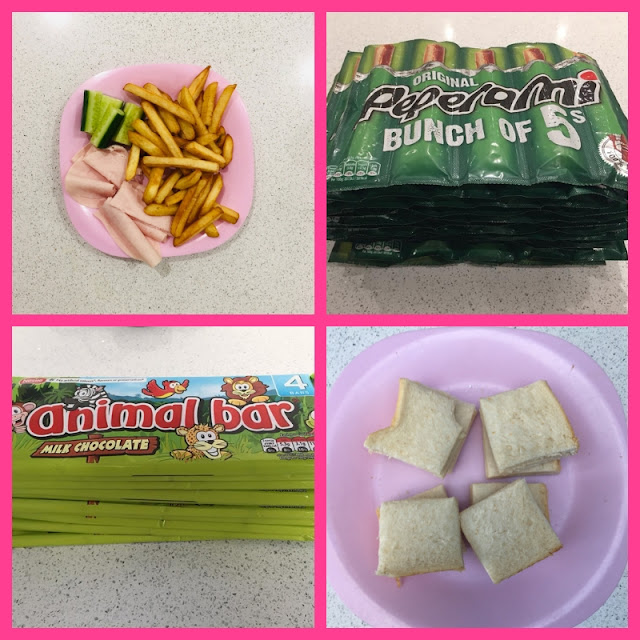There are many families out there who struggle with trying to get their children to eat a varied diet, especially within the autism community. I've mentioned several times on here and on my Facebook page about Sasha's eating habits; this post was about the challenges we have with bananas, and this one about our bulk buys. Currently she eats a limited number of foods. Just seven on weekdays, nine at weekends.
As it's so few, I can list them for you; peperami sausages, potatoes (at school, not at home), white bread and dairylea sandwiches, Sainsburys own brand milk chocolate, sliced turkey from M&S, cucumber and oven chips. Then she adds banana and croissant at weekends, and very occasionally a bit of fresh, plain baguette. Oh, and the McDonalds chips once a week of course.
The same diet, every single day.
Looking at this written down here does make me feel worse in a way, because I know that others will be judging me for this. Why don't we 'just' make her eat? If only it was so simple. I envy those who have it easy on the food front, and if you don't have experience of these eating challenges, I implore you to never pass comment or judgement on those who do.
I often think that those who have children who will eat anything, or who at least eat a variety of foods, cannot understand how we got to this position. In all honesty, I can't understand it myself, but I do know that it's not because I'm lazy and haven't ever tried to feed the girls other foods. Even ones we don't eat ourselves - no-one else in the house eats peperami sausages and I honestly can't recall how Sasha started that habit!
However, I will admit that the battles over food become very tiring at times. There definitely have been stages where we've taken a step back, taken a deep breath and parked those battles for a while, in order to have energy to focus on other challenges. Of course Sasha hasn't eaten only exactly these items for the past eleven years she's been on this earth; when younger, there were other foods which she used to eat. There are always phases; Petit filous, Animal bars and Babybels spring to mind. It certainly feels like this current diet has been in place for at least four or five years though.
There are random times when Sasha will try something else, such as this Subway sandwich a few months ago (when Subway became a firm favourite of her older sister), and the time when she was off school and so agreed to come to the supermarket with me (full blog post about that at this link). She chose a wide variety of things to try that time, but in the end she ended up only licking most of them, whilst deciding that there was nothing she could manage to eat going forward.
These times of trying are so few and far between, despite me regularly showing her new foods and offering options, so I didn't hold out much hope for this book. I did think it might be more helpful for our older daughter, who is definitely a 'fussy eater'. I'm not a fan of that phrase though; a bit like 'school refusal', it implies that there is a choice and people are doing it just to be awkward.
We all have different taste buds and different likes and dislikes regarding texture, and despite all the challenges we have had with food over the years I always manage to take deep breath and remind myself that it's not personal, they aren't trying to be annoying, just like I wasn't with my parents. Also, I remind myself that my two girls are actually doing OK healthwise. Sure some more (OK, a LOT more) fruit and veg would be lovely, but at least they eat some food. We've probably all heard the tale of the child who only ever ate weetabix or marmite sandwiches and managed just fine, haven't we?!
In our house we have occasionally tried blindfolded 'taste testing'. This is always kept as a fun, light hearted game where a variety of food is brought in on a plate and the girls can nibble or lick the food without judgement. This has resulted in surprise at times as new flavours have been discovered, even if they haven't become regular favourites.
Back to the book 'Get Your Kids to Eat Anything' then. Do I recommend this? Oh yes. Absolutely. Let me explain why.
Emily's eleven year old son is autistic, and her daughter has a long history of chronic throat infections. She has in no way made this a focus of the book, in fact it's only mentioned briefly in the introduction, but I think it's an important point. It means she really does understand the challenges, and this book is not about just handing out recipes. Her philosophy of 'make new the norm' is based on the idea of trying to introduce a variety of foods in a variety of ways, of making food fun and interesting, and different, so that new is not unexpected and something to be scared of.
When I first glanced at the book, I saw a couple of the images and instantly thought 'that looks way too healthy for my children to go anywhere near them'. I left it lying around, knowing I'd be doing a review of it at some point, but wondered what I would write. Then one evening, I decided to take a closer look. A couple of images jumped out as I flicked through, because they did look like things that I could at least get Tamsin to try.
Pancake plate art, and colourful fruit and veg lollies - as long as I didn't tell her about the fruit and veg of course. I started to read the introduction, and despite it being late at night, I couldn't stop. I read the whole book in one go.
The book begins by explaining the 5-phase approach:
1. Put the unfamiliar into the familiar
2. Educate
3. Discover the fun in food
4. Step into the unknown
5. Cement variety
There's a great introduction to ingredients, what you will need to stock up on, and then some tasks inviting you to deconstruct mealtimes - making a note of what is eaten regularly at home, and thinking about how it looks and tastes. Then questions about what different options could be introduced challenge the reader to think - could flavour be added to the peas, or a different kind of fish used for fishfingers? The book has an element of adventure to it, with hands-on food recipes.
The day after reading the book, I went to the supermarket and I looked at food I've never noticed before. Some of it I even bought. It was a start. That's how much of an effect Emily's writing had on me, and I'm sure it will help others too.
Yes, there are 'healthy' recipes in the book that I'm pretty sure will never be touched, but there are also lots of other ideas that are a good starting point to changing mealtimes and introducing new food in a different way. Strawberries and cream pasta?! Yes, please!
Tomorrow, I'll be treating myself to a homemade apple pie smoothie! Do I think that Sasha will be trying one of the recipes anytime soon? It'll be a work in progress, that's for sure. We might start with the rainbow pizza....
Feeding children who are not happy to eat anything is a challenge. Anything is worth a try though. You just never know when something might work, so my advice is to not give up completely. It's a case of finding the right time. And this book will definitely help with new ideas and could inject a new lease of life into your own cooking for yourself. Out now, via all the usual bookstores and on Amazon here: Get Your Kids To Eat Anything.
To find out more about our experiences, please check out our 'About Us' page. If you are looking for more information on Pathological Demand Avoidance, the posts below may help.
What is PDA (Pathological Demand Avoidance)?
Ten things you need to know about Pathological Demand Avoidance
Does my child have Pathological Demand Avoidance?
The difference between PDA and ODD
Strategies for PDA (Pathological Demand Avoidance)
Pathological Demand Avoidance: Strategies for Schools
Challenging Behaviour and PDA
Is Pathological Demand Avoidance real?
Autism with demand avoidance or Pathological Demand Avoidance?
To follow me on other social media channels, you can find me at the following links or click the icons below!
Facebook: www.facebook.com/stephstwogirls
Twitter: twitter.com/stephstwogirls
YouTube: www.youtube.com/c/stephcurtis
Instagram: www.instagram.com/stephstwogirls/



























No comments:
Post a Comment
Comments are always very much appreciated and can really help the conversation go further...